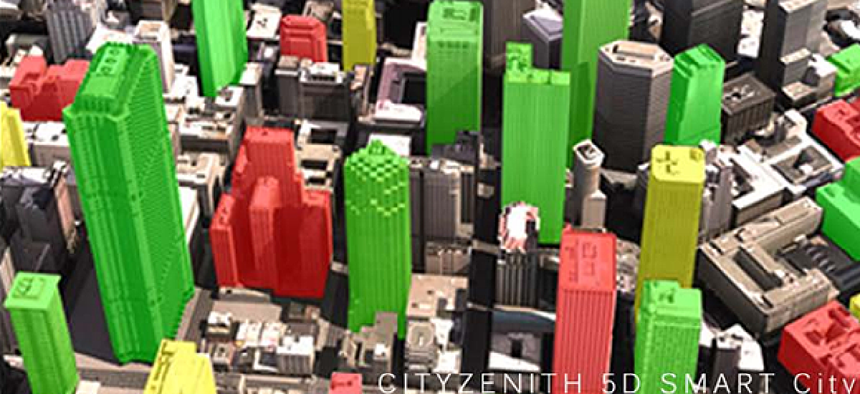San Francisco focuses IoT platform on energy data streams


Connecting state and local government leaders
San Francisco is acting as anchor to a group of firms mapping real-time building energy usage data as well streaming information from traffic monitors and mobile devices.
The 5D Smart San Francisco 2030 District, a joint undertaking of the city of San Francisco, software-as-a-service (SaaS) platform provider CityZenith and Lawrence Berkeley National Lab, is moving from a prototype to a deployment state, according to its developers.
The project began when CityZenith approached the city in search of a pilot project for its data visualization platform that consolidates city data in an easy-to-use, single point-of-view. The firm’s 5D Smart City platform is a cloud-based, SaaS solution that maps data created by cities – including open data, information from devices comprising the Internet of Things, machine-to-machine communications and social media – to an, interactive 3D interface designed for easy access by non-technicians.
In San Francisco, building a coalition to create data and analytics tools to chart local energy consumption and conservation took off fast. "Our original goal was to work with the Department of the Environment to visualize compliance with the city's green building ordinance," said Michael Jansen, CEO of CityZenith.
The original plan was to incorporate the city's annually aggregated data on the energy consumption of city buildings into CityZenith's platform for analysis and display. But the group’s plans quickly grew to include other information, including real-time data. "Now we're starting to layer additional sets of relevant data to create a more complex and dynamic understanding of the scope and breadth of the problems as well as the scope and breadth of the available solutions to the problems," said Jansen.
Data providers currently working with the project include EcoMesh, which provides real-time energy usage data, StreetLightData, which combines and analyzes data streams from real-time traffic monitors and wireless mobile devices and Helios, which offers an integrated suite of building analytics related to energy retrofits.
Lawrence Berkeley National Laboratory is contributing its expertise in data and modeling tools to the project. With Tianzhen Hong as LBNL’s project lead, the team is helping define data needs, developing new data tools and providing technical support to make the project’s efforts compatible with off-the-shelf tools provided by national labs.
"The city is acting as the anchor by ensuring that we provide basic information about how large commercial buildings are performing and their annual energy consumption,” said Barry Hooper, a private-sector green building specialist. “Our starting point is to offer a clear visualization of the annual energy consumption data and then to invite in other players who have more detailed information."
Hooper said he envisions the project as a way to increase awareness on the part of planners and building owners and to encourage the adoption of best practices and best-in-class energy management solutions.
"Cities have generated more data in the past couple of years than they have in the previous hundreds," added Jansen. "And the vast majority of that is unstructured and therefore either unused or underused. We're now working with ways to make that data more useful, visible and interactive."
The initial model of 5D Smart San Francisco was expected to be released by the end of February, with additional datasets to be linked in over the following weeks.
However, as is common with emerging technologies, such as IoT applications, adoption is being somewhat slowed by concerns about security and a lack of standards.
With respect to security concerns, the Federal Trade Commission in January released a report, “Internet of Things: Privacy & Security in a Connected World,” warning that connecting a wide array of insecure devices presents potentially major risks.
According to the report, "Unauthorized persons might exploit security vulnerabilities to create risks to physical safety in some cases." The report cited one instance in which a hacker was able to access two different connected insulin pumps and change their settings so that they no longer delivered medicine. In another case, a hacker was able to access a car's telematics unit and take control of the vehicle's engine and braking systems.
"Although the risks currently may be small, they could be amplified as fully automated cars, and other automated physical objects, become more prevalent," said the report.
As for IoT standards, the major push is by the Industrial Internet Consortium, a non-profit group formed by AT&T, Cisco, General Electric, IBM and Intel in March 2014. Already the group has more than 150 members, including a handful of major universities.
In response to both security and standardization concerns, NIST launched a public working group in June 2014 to explore the array of related issues facing those working to implement IoT projects in both the public and private sectors.
This article was changed March 4 to correct a quote by Michael Jansen who said, "We're now working with ways to make that data more useful, visible and interactive."

NEXT STORY: Smartvue puts video surveillance in Azure Government cloud




